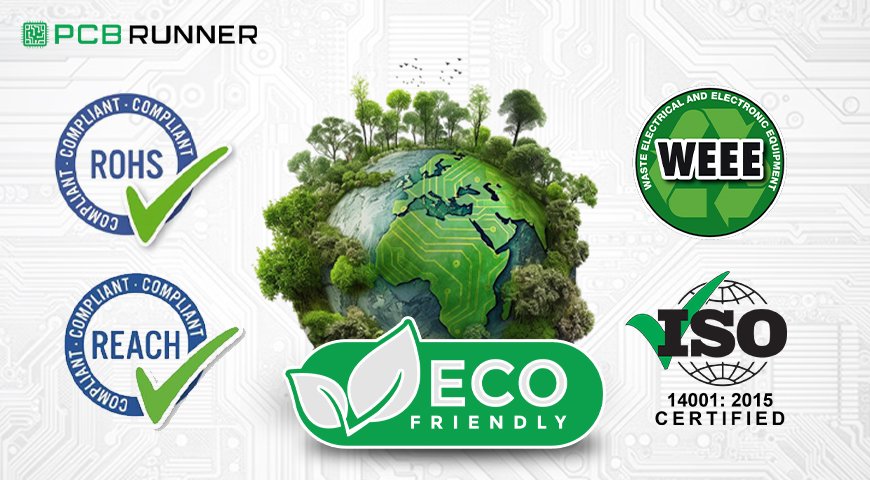Giving careful consideration to sustainability practices has become crucial, especially in the electronics sector. Due to heightened environmental concerns, PCB producers are implementing innovative manufacturing methods that use less hazardous materials. This is great for the planet, but it also increases the effectiveness and creativity within the circuit board assembly process. Thanks to green PCB technology and newer fabricated materials, the future of electronics is sustainable.
The Environmental Impact of PCB Manufacturing
The standard production of PCBs made use of well-known dangerous substances that included lead, chromium, and brominated flame retardants. Each of these materials had its own unique health or environmental risk. There was a very apparent need for change, which is why the RoHS (Restriction of Hazardous Substances) and WEEE (Waste Electrical and Electronic Equipment Directive) regulations were introduced – to force the industry to reconsider its approach.
Hazardous Material Reduction
The most significant change stems from the industry adopting lead-free soldering technology. Leaded solders have always posed a risk, and while requiring higher reflow temperatures, lead-free solders increase environmental safety. Furthermore, halogen-free laminates are now part of the material the PCB board is made from, thus reducing the toxic emissions during the disposal process.
Developments in the Environmentally Friendly PCB Production Process
The leading PCB producers are adopting some new technologies that make assembling greener circuit boards possible.
1. Eco-Friendly PCB Materials
More manufacturers are adopting substrates derived from recyclable or biodegradable resources. Flame retardants based on phosphorus are replacing brominated compounds, which are used as substitutes with no loss in performance.
Advantages:
- Less hazardous waste
- Greater recyclability of electronic products
- Meeting international environmental standards
2. Fuel-Efficient Manufacturing Procedures
Processes such as soldering and etching, which were previously considered energy-intensive, have been optimized. The addition of automation through teacher systems minimizes the energy needed for production.
Primary Improvements:
- Smart pick-and-place machines that enable streamlined assembly
- Defect reduction through automated testing and inspection systems
3. Innovative Green PCB Connectors
New green PCB connectors, which enable energy consumption reduction and increased product lifespan, are being incorporated into a myriad of electronic devices. These connectors can support data transfer while complying with environmental regulations.
4. Water Recycling Systems
The PCB manufacturer’s approach entails using closed-loop water recycling systems to mitigate water waste, which aids water conservation and reduces pollutants’ emissions into the environment.
Sustainable Usage of Green PCBs
Different industries, including renewable energy, electronics and many others, are set to benefit from what green PCB technology has to offer.
Renewable Energy Solutions
Solar panels, wind turbines, and energy storage systems all utilize PCB assemblies. Green manufacturing ensures that these components are manufactured efficiently and reasonably for the environment.
Wearable Electronics
New-age wearable devices are made possible by flexible and biodegradable PCBs, which help mitigate electronic waste.
Smart Home Devices
More eco-friendly devices utilize energy-saving designs of PCBs in smart home technology, which enhances sustainability in day-to-day activities.
Challenges and Future Outlook
- Material Costs: As in many environmental problems, eco-friendly solutions tend to be more expensive and often unaffordable.
- Technical Limitations: It is not easy to achieve the previously mentioned performance metrics with greener materials.
- Consumer Awareness: Informing consumers of the importance of green electronics is also an issue.
Positioning oneself as an authority on sustainable manufacturing will pay off greatly as development and research proliferate.
Expert Insight
According to research made available by ResearchGate, sensors and wearable technology stand out as great continuous health care monitoring tools owing to the sophistication of green PCB technology. PCBs embedded with machine learning, along with wireless integration, make it possible for wearables to monitor vital signs round the clock and detect health issues in their earliest stages. There are still concerns over the accuracy of the sensors and their clinical validation. Still, the use of green materials in the PCBs of these gadgets is a stepping stone in lessening their post-consumer wastage.
Additionally, emerging regulations like RoHS and WEEE constantly shift the burden of proof towards manufacturers for adopting environmentally sound practices. The industry is challenged with the need to produce halogen-free laminates and cyanide-free gold-plated PCBs.
Conclusion
While these developments in green technology may seem beneficial, all claim that the transition to greener processes is a lot more difficult than it appears. By integrating post-consumer waste as raw material, making energy-efficient equipment, or inventing new green connectors for PCBs, manufacturers will contribute to making electronics environmentally friendly.
Are you looking for innovative green PCB solutions? If yes, then form a partnership with PCB Runner, one of the leading PCB manufacturing suppliers that prioritizes eco-friendly practices. Reach out today and get the best consultation for your green PCB design and circuit board assembly needs.
FAQs
What is a green PCB?
Green PCB refers to a printed circuit board manufactured using eco-friendly materials and processes that have less detrimental environmental effects.
Why are green PCB connectors critical?
They are crucial as they assist in the effective design of electronic circuits due to energy conservation and waste minimization.
What materials are used in eco-friendly PCBs?
Biodegradable substrates, flame retardants based on phosphorus, and laminates that do not contain halogens.
How do PCB manufacturers reduce energy usage?
Automation, machine learning, and energy-efficient devices are utilized to improve processes and minimize energy consumption.
How can PCB Runner help with green PCB manufacturing?
PCB Runner addresses the changing needs of the electronics industry with new technologies by providing PCB selection, prototyping, and even production.

